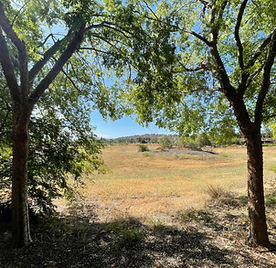Extreme Precipitation & Riverine Flooding
Extreme precipitation patterns from climate change lead to heavy rainfall events that cause rivers or creeks to overflow and flood the surrounding areas. Floods will increase in frequency and intensity, with areas that have not historically experienced flooding becoming increasingly exposed.
Nature-based Physical Interventions
Examples

Hale Creek Enhancement Pilot Project
Valley Water completed the Hale Creek Enhancement Pilot Project in Santa Clara in 2023. The project restored natural features and riparian habitat functions while improving flood protection along a 650-foot-long reach of Hale Creek. The project entailed widening and deepening the creek and installing a soft-bottom channel planted with vegetation, replacing concrete. This pilot is a local example of how to successfully convert concrete-lined channels reaching the end of their planned useful life to natural creeks with native plants and healthy creek habitat. This natural channel is more resilient to damage from more intense rainfall patterns caused by climate change.

Mycoremediation Pilot Project at Los Angeles Railyard
Toxicologist Danielle Stevenson is working with a team of UC Riverside students and other volunteers to remediate a railyard along the Los Angeles river. Funded by the City of Los Angeles, the team is using a unique nature based approach called mycoremedation to remove heavy metals and other pollutants. Over 12 months, the project removed almost all petrochemical pollutants at the site, while also restoring native plants and wildlife habitats along the waterfront. This effort will help boost climate resilience along the river and in nearby communities by preventing watershed contamination during extreme precipitation events and reducing urban heat with more green space.

Napa River Flood Protection
The Napa River had a history of catastrophic flooding events, impacting downtown Napa, tourism, and agricultural assets. After a long history of utilizing engineered solutions, a multi-faceted collaboration with stakeholders, the Army Corps of Engineers, businesses, and others worked together to develop an approach to let the river run free - a "Living River" concept that was then and is still groundbreaking. The Napa Flood Protection project is an early and lasting example of using natural systems to manage flooding while protecting important assets in an affordable, durable, and effective way.

Upper Penitencia Creek Flood Protection
This project is part of an ongoing partnership between Valley Water and the U.S. Army Corps of Engineers, to plan, design and construct improvements along 4.2 miles of Upper Penitencia Creek in Santa Clara. The creek is prone to flooding during extreme precipitation events. To enhance flood protection, the project is implementing both nature-based and grey solutions along the creek. The natural creek channel will be preserved and undergo ecological restoration while adjacent open space and parkland will remain as recreational areas, taking the role as a temporary floodplain so that floodwaters do not enter surrounding neighborhoods and commercial areas.

Calabazas Creek Flood Protection
Project to provide flood protection to 2,483 parcels in the Calabazas Creek watershed. A long detention basin next to the creek was built to capture high storm flows, preventing the creek from overtopping its banks in a 1% flood.
Valley Water repaired 14 severely eroding banks, using as little “hardscape” as possible. The project incorporated environmental stewardship principles to reduce erosion, with vegetation to enhance habitat for wildlife. Valley Water reduced the cost of the project by collaborating with the City of San José, which rebuilt a bicycle motocross (BMX) park at Calabazas Park.

Urban Forest “Vision Solano”
Sustainable Solano's Urban Forest “Vision Solano” project aims to green Solano County with trees and plants that support diverse ecosystems and provide shade, food, and habitat for wildlife. For this project, Sustainable Solano planted 60 trees in 2018 and 2019 throughout Shelter Solano, a local Fairfield homeless shelter, using a grant from the California ReLeaf Social Equity Tree Planting Program. These efforts converted the 3.5-acre area into a resilient, mixed-canopy urban forest complete with California native drought-tolerant trees and fruit trees. Community members participated in the creation of this urban forest while learning about sustainable landscaping practices and urban forestry for local communities.

Coyote Valley Preservation
In November 2019, 937 acres in Coyote Valley were permanently protected through an innovative public and private partnership among Peninsula Open Space Trust (POST), Santa Clara Valley Open Space Authority (OSA) and the City of San José. The $93.46 million acquisition deal was funded in part by Measure T, a $650 million infrastructure bond approved by San José voters in November 2018
















